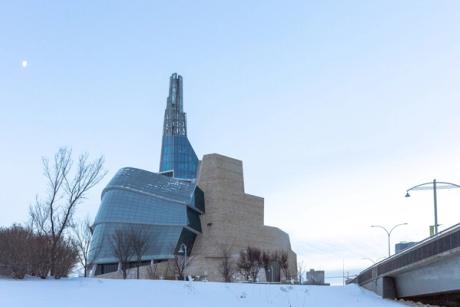
Palestinian solidarity groups, activists and community members marked International Human Rights Day on Sunday (10 December) by calling for an immediate ceasefire in Gaza and staging a mass “die-in”for 64 minutes at the Canadian Museum for Human Rights (CMHR) in Winnipeg. Co-organiser Alison Moule, an intern at Winnipeg’s Oseredok Ukrainian Cultural and Educational Centre, said that each minute of the protest represented one of the 64 days since Israel launched its war in Gaza in retaliation for Hamas’s 7 October terror attacks against Israeli communities.
“As a federally funded museum dedicated to representing human rights both in Canada and globally, we feel the CMHR should show more support for Palestinians amid the ongoing human rights crisis in Gaza,” Moule said.
While acknowledging CMHR’s support for a ceasefire in an Instagram post on 14 November that honoured the death of peace activist Vivian Silver, Moule said: “We know that a ceasefire is not enough. Because the CMHR is a federally funded museum, we were hoping to direct our action at the federal government as well as the museum, since the Prime Minister continues to side with Israel despite the extreme violence of their daily attacks on Gaza and elsewhere in Palestine.”
As a “Jewish museum worker”, Moule added, “it is critical to me that people understand that asking for an end to the violent apartheid in Palestine does not in turn mean wanting violence against Israelis or Jews worldwide. It is also important to me, that museums be held accountable when they exclude necessary perspectives. The effort to decolonise museums is ongoing and museums should listen when the public expresses dissatisfaction over their exhibits.”
Matthew Cutler, the CMHR’s vice president of exhibitions, did not reply to The Art Newspaper’s queries but said in a statement to The Winnipeg Sun that the museum has been working with the Palestinian Canadian community to develop new gallery content that will help Canadians “better understand the human rights violations Palestinians experience every day”, including oral history interviews with Palestinian Canadians and scholarly research that will inform the content currently being developed.
“This is a commitment we made long before the start of the Israel-Hamas war, and it will continue long after this current conflict ends,” Cutler wrote in the statement. “Our galleries will never be able to capture every element and experience of human rights. We are thankful for upstanders, protesters, educators and others who, like in [Sunday’s] protest, add context, perspectives and stories to complement what we are able to offer in our galleries.”
Palestinian Canadians have long complained of having their narratives excluded by the CMHR, which was founded by the late Canadian politician and media mogul Israel“Izzy” Asper, who died in 2003. Asper, who owned a dozen Canadian media outlets, was accused of editorial interference and pushing newsrooms to adopt stridently pro-Israel positions. Montreal Gazette editor Michael Goldbloom resigned in 2001 after senior editors there were ordered to run a pro-Israel editorial. After Asper’s death, his daughter Gail Asper led the museum project, via the Asper Foundation and the Friends of the Canadian Museum for Human Rights.
Canada’s only national museum outside of the capital region in and around Ottawa, CMHR is federally funded at approximately C$22m ($16.2m) annually and since its opening in 2014 has been the subject of other controversies. These include concerns about First Nations archaeological remains at the site of the museum and the censorship of LGBT material for tours of certain religious and educational groups. Former chief executive John Young decided not to seek reappointment in 2020 after allegations of racism and homophobia.
“It’s true that the CMHR has a small display of a story about a doctor from Gaza, but they leave out key context, like the Nakba of 1948 and the many, many human rights violations Palestinians have experienced since,” Moule said. That CMHR exhibit concerns Gazan doctor Izzeldin Abuelaish, who lost three daughters and a niece to an Israeli bombing in 2009, as part of a larger exhibition profiling 17 individuals including musician Buffy St Marie and entrepreneur Craig Kielburger. The museum’s displays do not mention of the Nakba (Arabic for “catastrophe”), the forced displacement of more than 700,000 in 1948.
In 2013, before the CMHR opened, Canadian Palestinian activist Rana Abdulla (whose efforts to have stories she collected from Nakba survivors in Canada integrated into museum exhibits were rebuffed) told the CBC: “Palestinians have a critical human rights story that should be fully presented in the museum.”
On Tuesday, Canada joined 152 other members of the United Nations General Assembly in voting for a non-binding resolution calling for an “immediate humanitarian ceasefire” in the Israel-Hamas war. “What is unfolding before our eyes will only enhance the cycle of violence,” Mélanie Joly, Canada’s minister of foreign affairs, said before the vote. “This will not lead to the durable defeat of Hamas.”
According to the Hamas-run health ministry in Gaza, more than 18,000 Gazans have been killed since Israel launched its assault on 7 October. In that day’s terror attacks against Israel, Hamas terrorists killed more than 1,200 people in communities near the border with Gaza, and took more than 240 people hostage. More than 100 of those hostages were released during a week-long ceasefire last month, in exchange for Israel’s release of several hundred Palestinian detainees.










